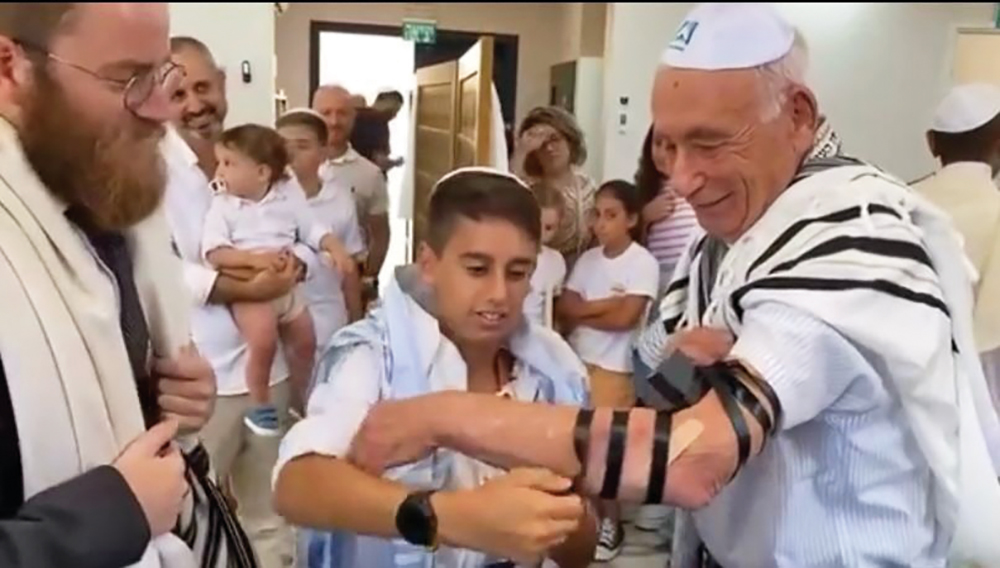Translated by Yehoshua Siskin

Increasing Our Joy
People in Israel were smiling as they walked down the street on Monday morning and no one had to ask them why.
Fernando Marmen and Luis Har, brothers-in-law who were abducted from Kibbutz Nir Yitzhak on Oct. 7, were rescued on Sunday night from Hamas captivity.
Thank God.
It happened while we were sleeping, in a complex and daring operation involving numerous special forces. We offer tremendous thanks to all the unknown heroes. In the future, we’ll find out more details and generations will discuss the details of the operation, but for now, thank you.
“When Adar arrives, we increase our joy” and the month has only begun. It’s a month when we reflect on two words from Megillat Esther — “venahafoch hu,” a reminder that things can turn around in a moment. The Jews who were under the threat of annihilation were saved, and the wicked Haman was eventually hanged on the gallows. May this happen to all our enemies.
And this is what Ditzah Or, the mother of hostage Avinatan, has been saying in every interview: believe in good, imagine good news, and visualize only the best scenarios.
Last Saturday night at Havdalah, after spending a special Shabbat with families of the kidnapped, I stood next to Shelly, the mother of Omer Shem Tov, and next to Orly, mother of Daniella Gilboa. Both are still in Gaza. All the family members sang together loudly, over and over, the words said in Havdalah, which also appear at the end of Megillat Esther when everything turns out well: “The Jews had light and joy and gladness and honor.” Amen, may it happen very soon.

Kaddish for Every Kadosh
Rabbi Reuven Targin of the World Mizrachi movement wrote about a new project: “Jews around the world feel very close to what is happening here, but also very far away. They try to help and connect in any way they can. We have now created a new way for the Jews of the world together with Dror Amos, the Israeli who founded the site ‘Kaddish for every Kadosh.’
“They can connect with the bereaved families, not just for one day or one week, but for an entire period: simply say Kaddish for one of the fallen to really connect with them. There are many people who have no one to say Kaddish for them now and their families are looking for volunteers. Later, meetings will be held between the Jews who say Kaddish and the family members of the fallen.”
May all the prayers be accepted. For more details: holy.hhe.org.il/en/kaddish-lkol-kadosh.
An 89-Year-Old Bar Mitzvah Boy
Rabbi Mendy Ashkenazi, a Chabad shaliach in the Eilat-Arava region of southern Israel, described an unprecedented event at the bar mitzvah of Ariel Cohen from the community of Be’er Ora, located some 12 miles north of Eilat.
Ariel’s great-grandfather, Yitzchak Barkan, a lieutenant colonel in the IDF reserves and a former fighter pilot and air force commanding officer, made a special trip from his home in Ramat Hasharon to participate in his first great-grandson’s bar mitzvah. After the Torah reading, he shared that at 89, this was his first time entering a synagogue. He expressed how moved he was by the ceremony’s beauty and inspiration.
Barkan related that on Kibbutz Givat HaShlosha, where he grew up, they marked his 13th birthday with a gift of 13 bananas — that was the extent of the celebration. When Rabbi Ashkenazi asked him if he’d ever put on tefillin, he said that he never had, but would like to do so now.
“And here, something very moving happened: Ariel, the bar mitzvah boy, removed his new pair of tefillin and put them on his great-grandfather,” Rabbi Ashkenazi related. “I don’t know who was moved more, great-grandfather or the great-grandson!”
They say that a bar mitzvah is a link in a chain of tradition that keeps moving forward, generation after generation. But in this case, another kind of link to tradition was created, one that went backwards in time.
Holes in the Wall and Letters Floating in the Air
Since Oct. 7, the police station in Sderot has become synonymous with a devastating tragedy. Yet now, those who visit are greeted by a powerful work of art. Elyasaf Miara, the artist behind the evocative painting, shared his vision:
“I began by depicting the wrecked edifice, facing off against a tank — a stark juxtaposition of war machinery invading the serenity of a town.
“Central to the piece is an open sefer Torah, representing Simchat Torah. On that fateful day, eight officers inside the station and two responders were lost — 10 souls, a minyan. My initial thought was to perforate the scroll with 10 holes in their memory, but afterwards I discovered 10 actual bullet holes in the wall, and I encircled the Torah scroll around these marks, instead.
“Floating above the sefer Torah, are the letters of the aleph beit. I wept as I painted them, thinking how those letters form the names of the fallen and of our entire nation. Our Sages state that it’s possible to burn a sefer Torah, but the letters, along with the nation’s spirit, are indestructible. This is the message of consolation and hope that I’ve attempted to bring to our people.”
Sivan Rahav Meir is a primetime news anchor on Israeli television with a regular column in Yediot Aharonot, Israel’s largest newspaper, and a weekly radio show on Galei Tzahal (Army Radio). She has a tremendous following on social media for her insights into Jewish life and tradition. Her lectures on the weekly Torah portion are attended by hundreds, and the live broadcast attracts hundreds of thousands more viewers across the globe. She was recognized by Globes newspaper as the country’s most popular female media figure and by the Jerusalem Post as one of the 50 most influential Jews worldwide. She lives in Jerusalem with her husband Yedidya and their five children.










